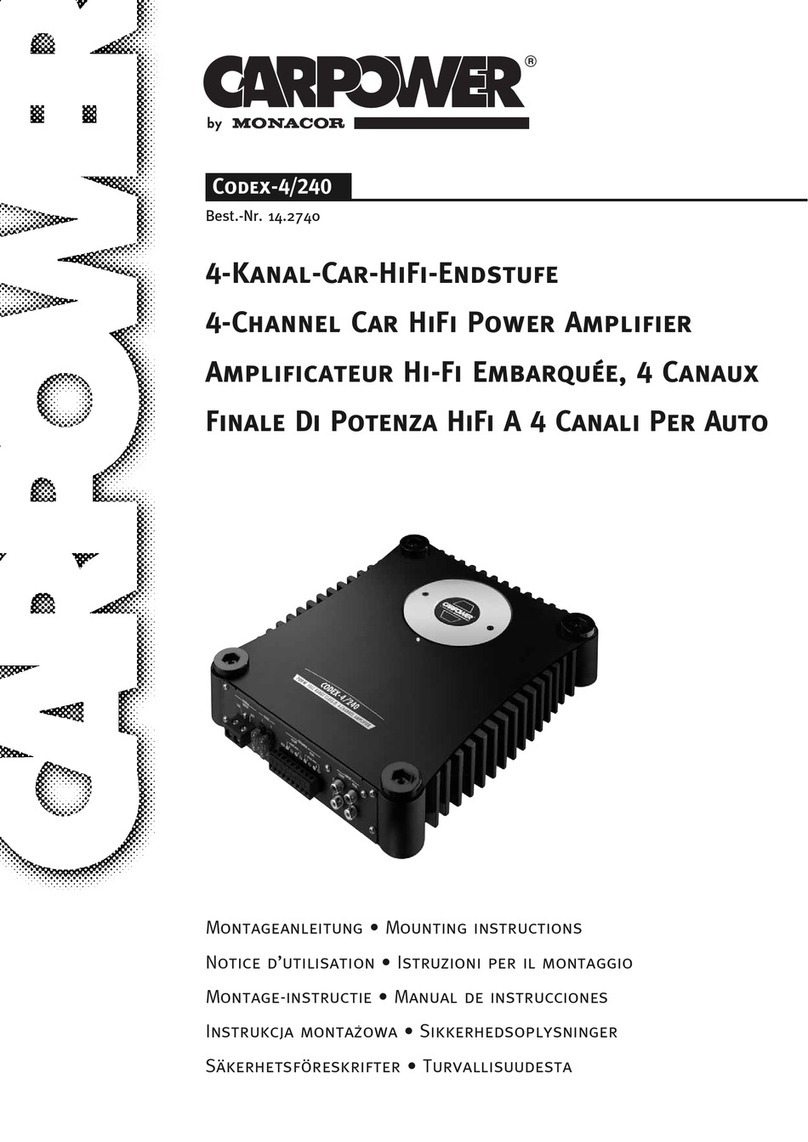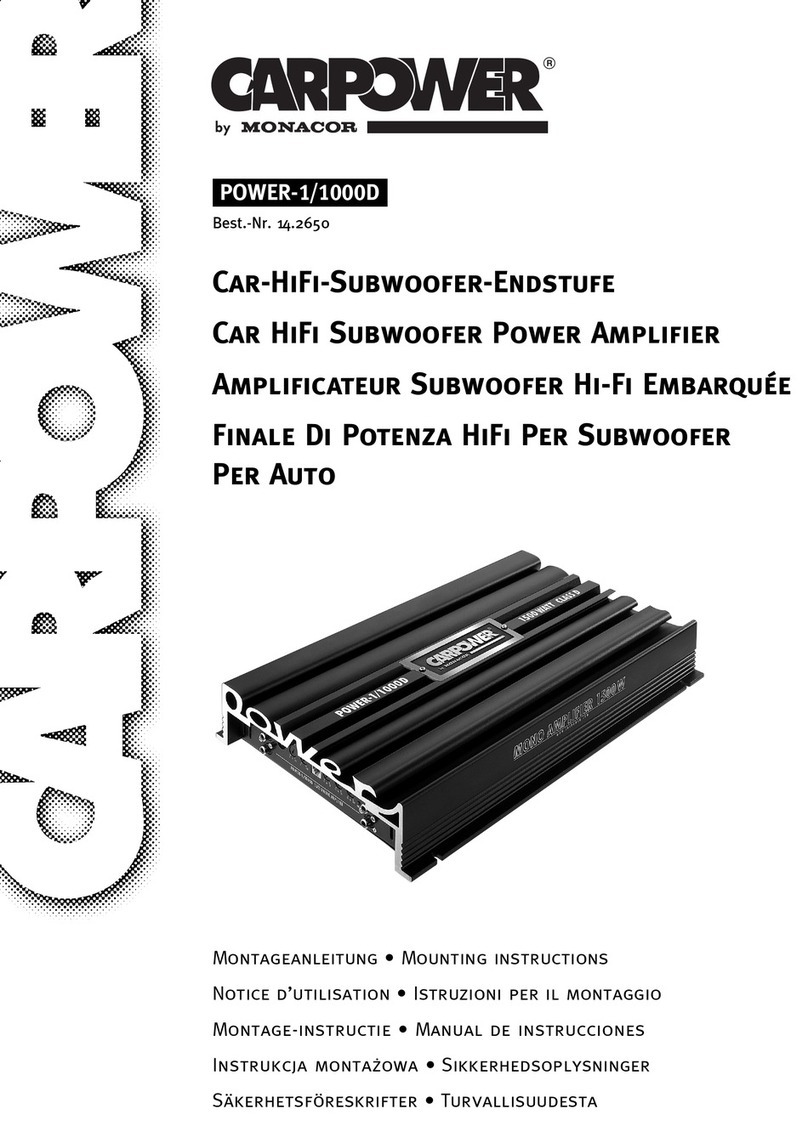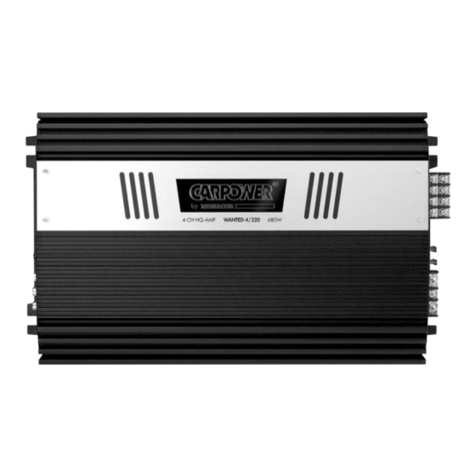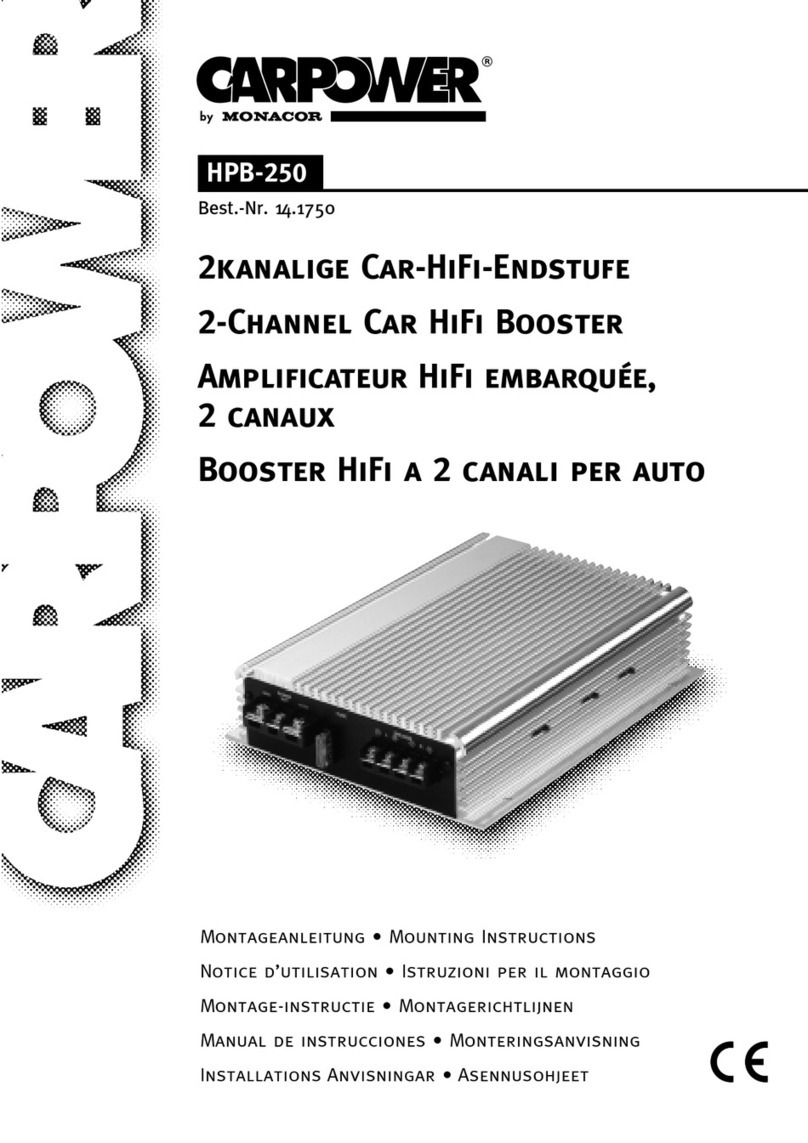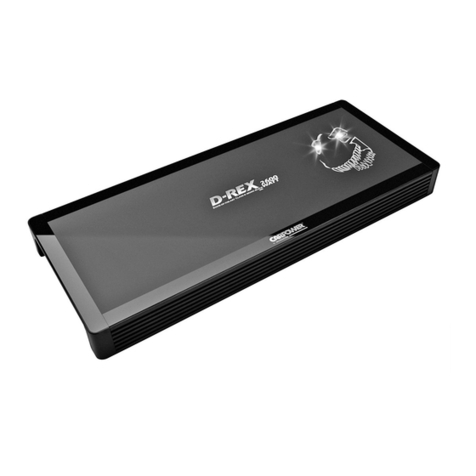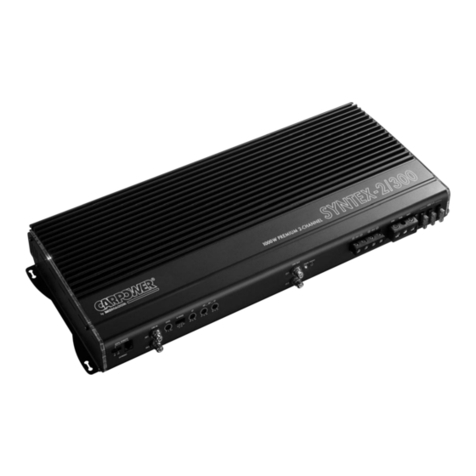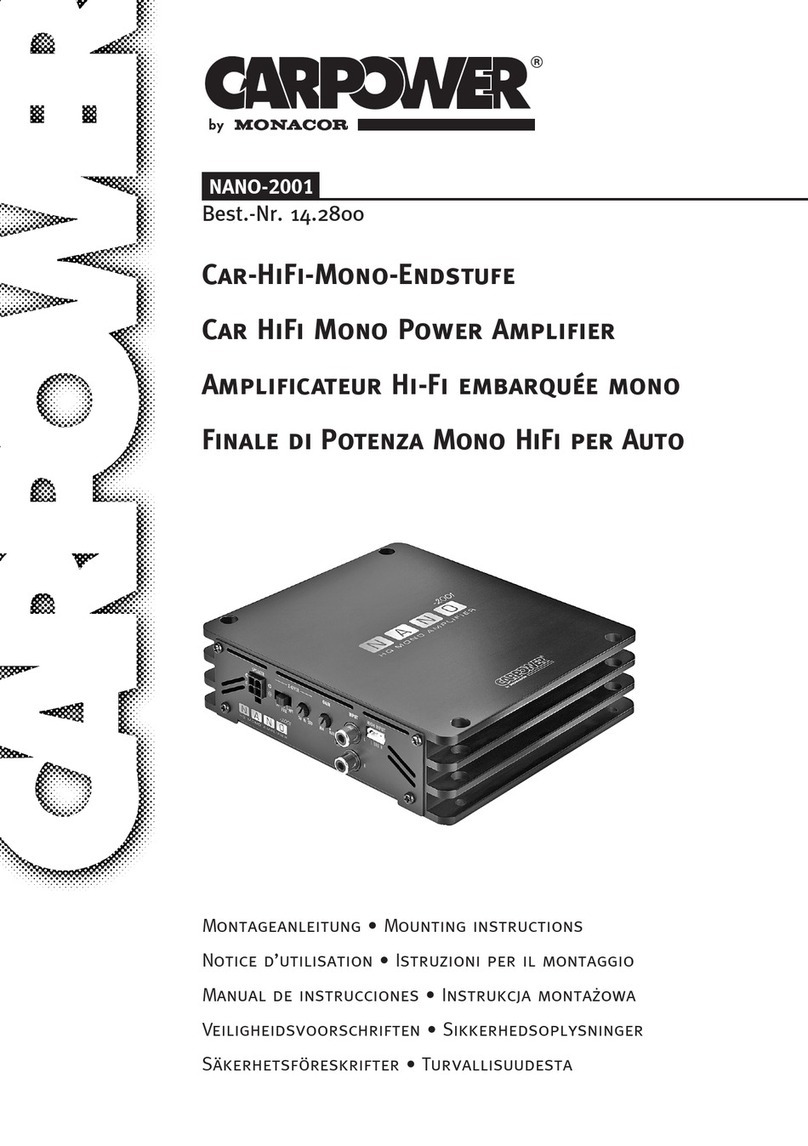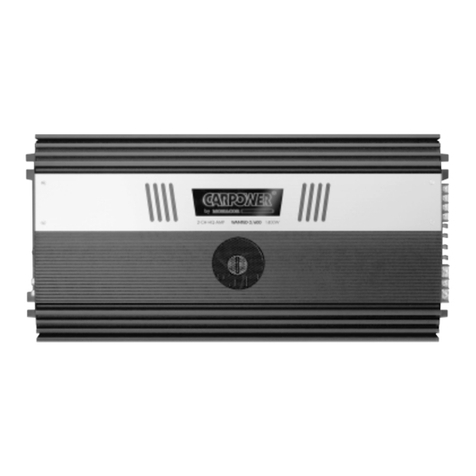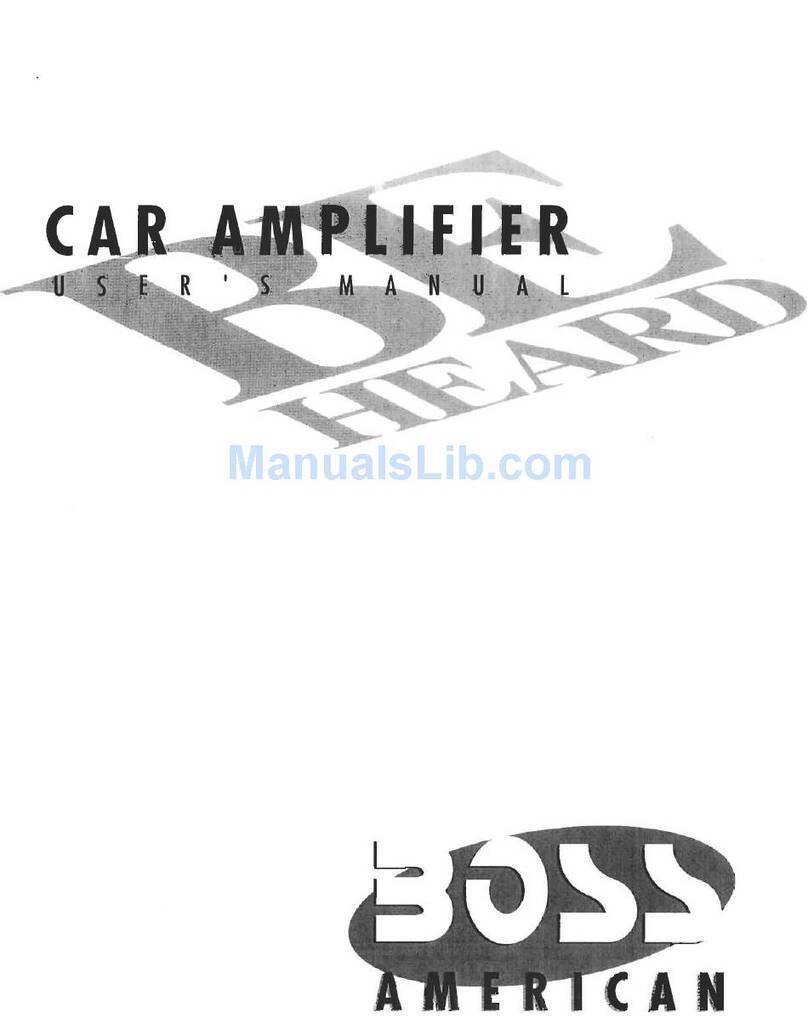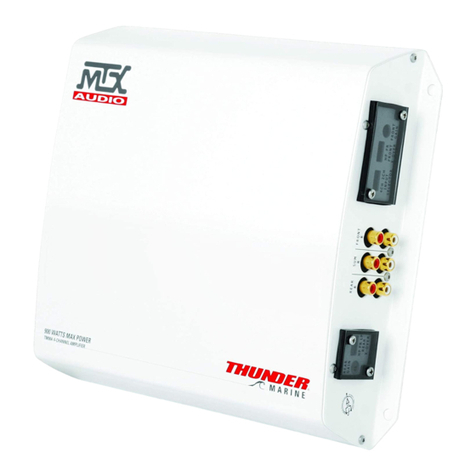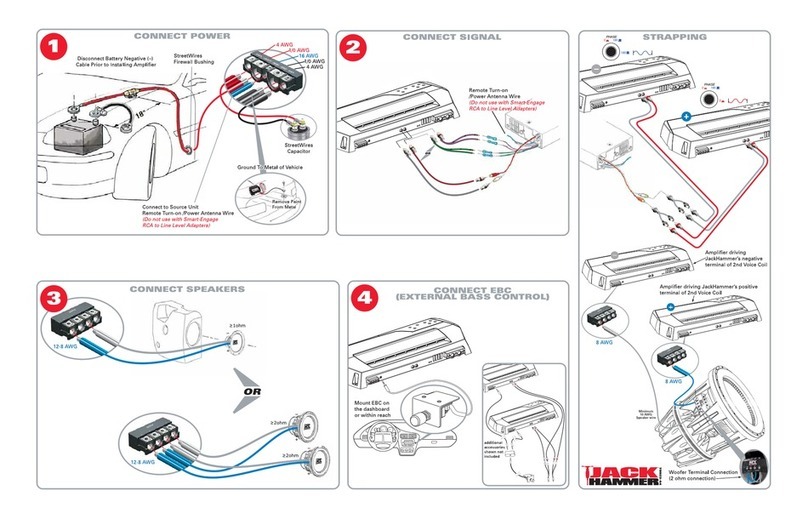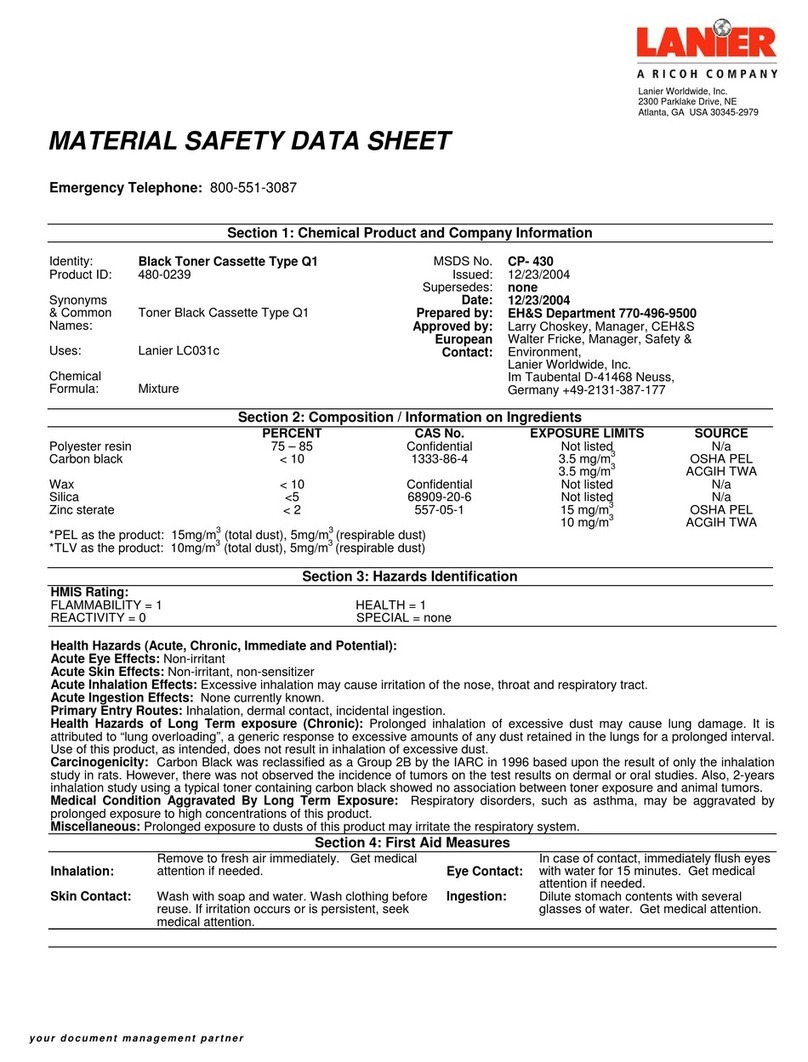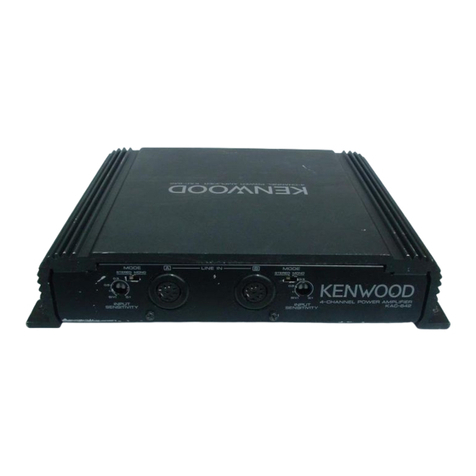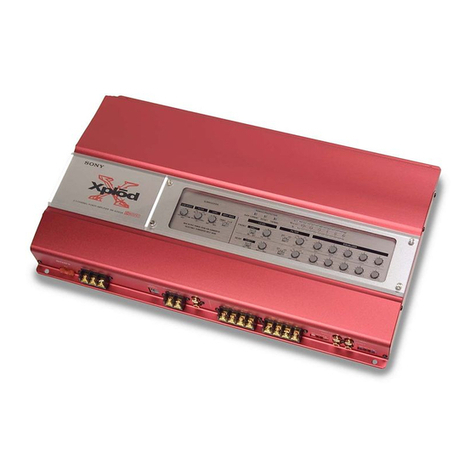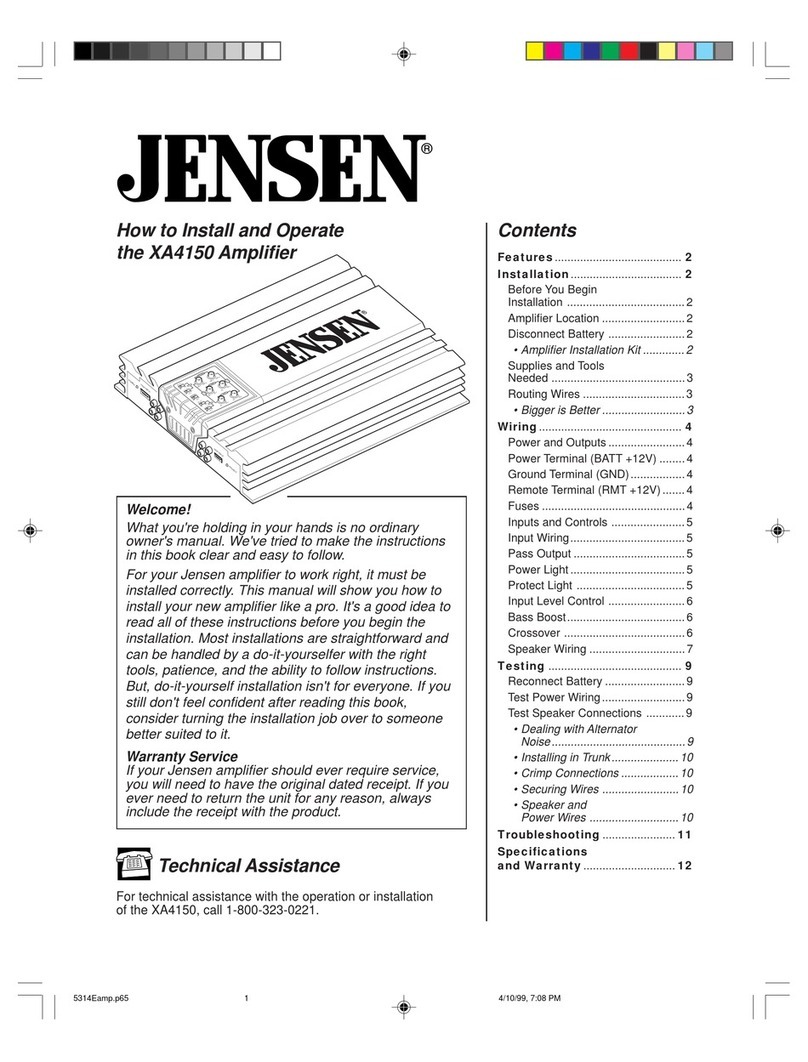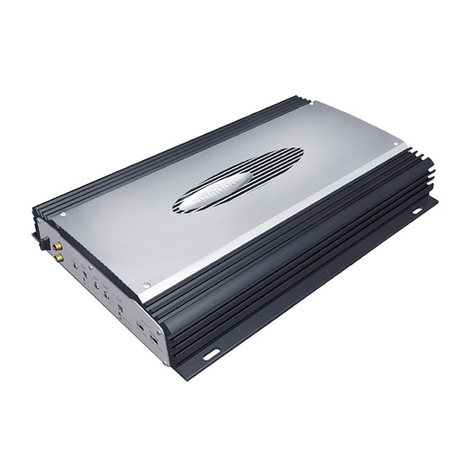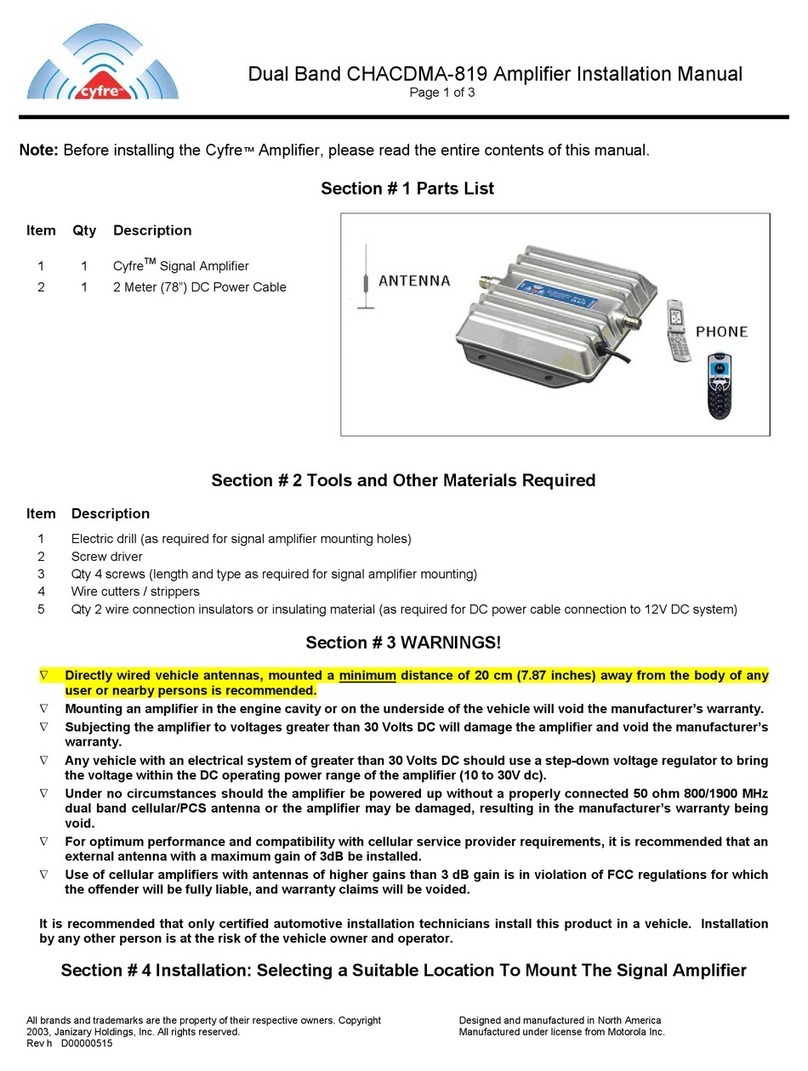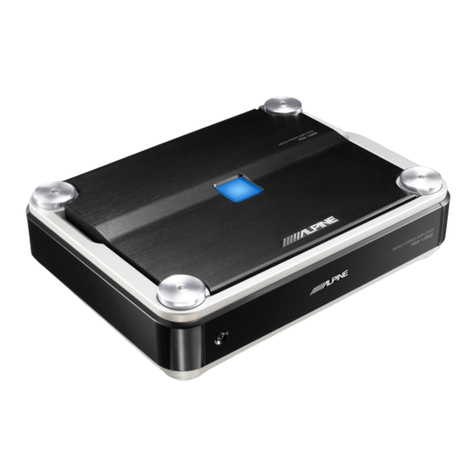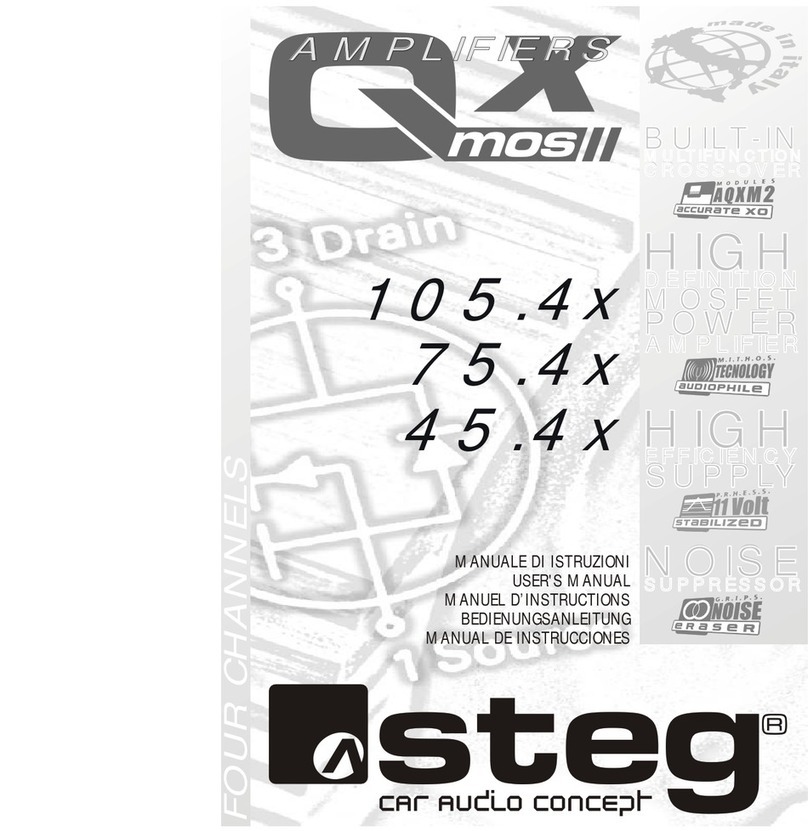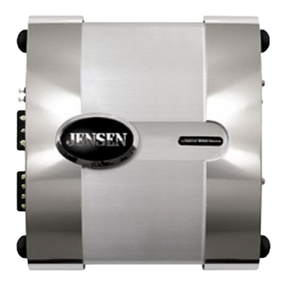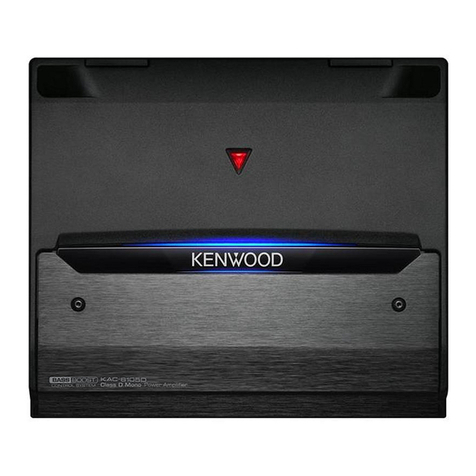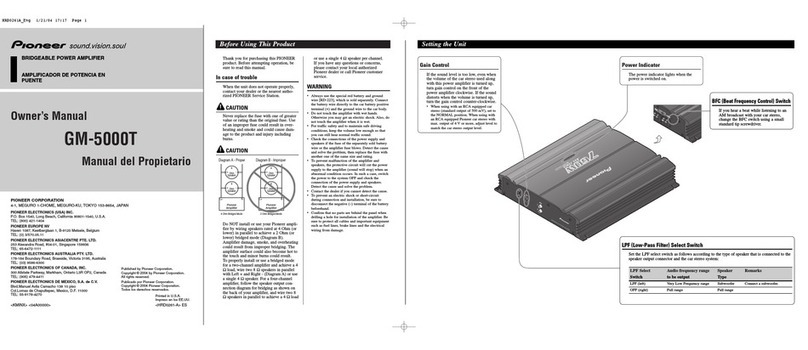
8
English
•
As forces occur during braking, the power
amplifier must tightly be screwed to a
mechanically stable place.
•
The fuses and the controls must be ac-
cessible.
The power amplifier should be installed elec-
trically insulated from the car chassis. Tightly
screw the amplifier with the four fixing brack-
ets at a suitable place.
6 Connection of the
Power Amplifier
•
The connection of the car HiFi power
amplifier to the electric system of the car
must only be carried out by authorized
personnel.
•
To prevent damage in case of a short circuit
during installation, always screw off the
negative terminal from the car battery prior
to connecting the power amplifier.
•
Lay the necessary cables so that their insu-
lation cannot be damaged.
The complete connection is shown in figs. 3
to 6 on page 3.
6.1 Power supply
6.1.1 Operating voltage
Connect the terminal “+12V” (12) via a high-
power cable to the positive terminal of the car
battery. To keep the voltage loss by the cable
as low as possible, a minimum cross section
of 8 mm2should be used, e.g. CPC-100/RT.
To protect the newly laid 12V cable against
a short circuit, insert an additional 50A fuse
very close to the battery (max. cable length
to the battery 20cm).
To stabilize the operating voltage for the
power amplifier and thus the resulting power
increase and sound improvement, a power
capacitor is recommended.
6.1.2 Ground connection
Connect the ground terminal GND (10) via
a high-power cable with a minimum cross
section of 8mm2(e.g. CPC-100/SW) to the
ground of the car or perferably directly to the
negative terminal of the car battery.
Notes:
1. When using the chassis as a ground connection,
the place used must have a good electrical contact
to the main chassis (e.g. by a sufficient number
of welding points). Any lacquer at the point of
contact must completely be removed.
2. To avoid ground loops, the ground of the car radio
must be applied at the place where also the power
amplifier is grounded.
6.1.3 Control voltage for switching-on
The car HiFi power amplifier is switched on
and off by a control voltage of +12V at the
terminal REM (11). Connect the terminal
REM to the 12V control output of the car
radio (e.g. connection for a motor antenna,
if necessary, to be connected in parallel to the
motor antenna).
6.2 Inputs
Connect the two jacks INPUT (2) via cables
with RCA connectors to the corresponding
line outputs at the car radio. If the car radio
is not equipped with line outputs, the speaker
outputs of the car radio can be connected
via an transformer (e.g. FGA-22HQ) to the
inputs of the power amplifier. The connection
depends on the desired operating mode of
the power amplifier:
6.2.1 4-channel operation (fig. 3)
Set the switch CHANNEL (8) for the 4-chan-
nel operation to position “4”. Connect the
outputs of the car radio to the jacks INPUT
CH 1 to CH 4 (1 and 2) as follows:
front left to channel 1
front right to channel 2
rear left to channel 3
rear right to channel 4
If the car radio is not equipped with outputs
for the rear channels, connect the output
of the left channel via a Y cable (e.g. CBA-
25/SW) to the input jacks of the channels 1
and 3 and the output of the right channel
via another Y cable to the input jacks of the
channels 2 and 4.
6.2.2 Active 2-way operation (fig. 4)
Set the switch CHANNEL (8) for the active
2-way operation to position “2”. Connect the
outputs of the car radio to the jacks INPUT
CH 3 and CH 4 (2):
left channel to channel 3
right channel to channel 4
The channel 1 receives the signal from input3
and the channel 2 from input 4.
6.2.3 Bridge operation (fig. 5)
If, in bridge operation, the channels 1 and 2
are to drive the left speaker, and if, in bridge
operation, the channels 3 and 4 are to drive
the right speaker, connect the output of the
left channel at the car radio via a Y cable (e.g.
CBA-25/SW) to the jacks INPUT CH 1 and
CH 2 (1) and the output of the right channel
via another Y cable to the jacks INPUT CH 3
and CH 4 (2). For this purpose, set the switch
CHANNEL (8) to position “4”.
6.2.4 3-channel operation (fig. 6)
Set the switch CHANNEL (8) for the 3-chan-
nel operation to position “3”. Connect the
outputs of the car radio to the jacks INPUT (1
and 2) as follows:
left channel to channel 1
right channel to channel 2
subwoofer L to channel 3
subwoofer R to channel 4
If the car radio is not equipped with outputs
for a subwoofer amplifier, connect the inputs
of the channels 3 and 4 to the two jacks OUT-
PUT (9) [see fig. 6].
6.3 Line output
The mono signal of the inputs 1 to 4 is avail-
able at both jacks OUTPUT (9). If a subwoofer
amplifier is to be inserted into the car HiFi sys-
tem and if the car radio is not equipped with
outputs for a subwoofer amplifier, the inputs
of the subwoofer amplifier can be connected
to the jacks OUTPUT (also see chapter 6.2.4,
if necessary).
6.4 Speakers
It is possible to use full range speakers (2-way
or 3-way speakers), mid-high range speakers,
bass speakers, or a subwoofer.
Important! All speakers must be connected
with 2 poles, i.e. without common ground
connection. When choosing suitable speak-
ers, pay attention to their mechanical and
electrical capability in connection with the
power used of the power amplifier (also see
specifications page 9).
The highest output power is reached when
connecting 2Ω speakers or a speaker group
with a total impedance of 2Ω per channel
(e.g. two 4Ω speakers connected in parallel).
However, it is also possible to connect indi-
vidual 4Ω speakers; in this case, the output
power is slightly reduced.
Attention! The impedance of the speakers
or the total impedance of speaker groups
which are driven in bridge operation must
not fall below 4Ω!
Connect the speakers to the terminals
SPEAKER (16). The exact connection of the
speakers depends on the desired operating
mode of the power amplifier:
6.4.1 4-channel operation
Also see fig. 3.
CH1 L+ positive pole speaker left front
CH1 L− negative pole speaker left front
CH2 R+ positive pole speaker right front
CH2 R− negative pole speaker right front
CH3 L+ positive pole speaker left rear
CH3 L− negative pole speaker left rear
CH4 L+ positive pole speaker right rear
CH4 L− negative pole speaker right rear
6.4.2 Active 2-way operation
Also see fig. 4
CH1 L+ positive pole left bass speaker
CH1 L− negative pole left bass speaker
CH2 R+ positive pole right bass speaker
CH2 R− negative pole right bass speaker
CH3 L+ positive pole
left mid-high range speaker
CH3 L− negative pole
left mid-high range speaker
CH4 L+ positive pole
right mid-high range speaker
CH4 L− negative pole
right mid-high range speaker
6.4.3 Bridge operation
While connecting, pay attention to the letter-
ing “BRIDGE”, also see fig. 5.
CH1 L+ positive pole left speaker
CH1 L− remains unconnected
CH2 R+ remains unconnected
CH2 R− negative pole left speaker
CH3 L+ positive pole right speaker
CH3 L− remains unconnected
CH4 L+ remains unconnected
CH4 L− negative pole right speaker
6.4.4 3-channel operation
Also see fig. 6
CH1 L+ positive pole left speaker
CH1 L− negative pole left speaker
CH2 R+ positive pole right speaker
CH2 R− negative pole right speaker
CH3 L+ positive pole subwoofer
CH3 L− remains unconnected
CH4 L+ remains unconnected
CH4 L− negative pole subwoofer
